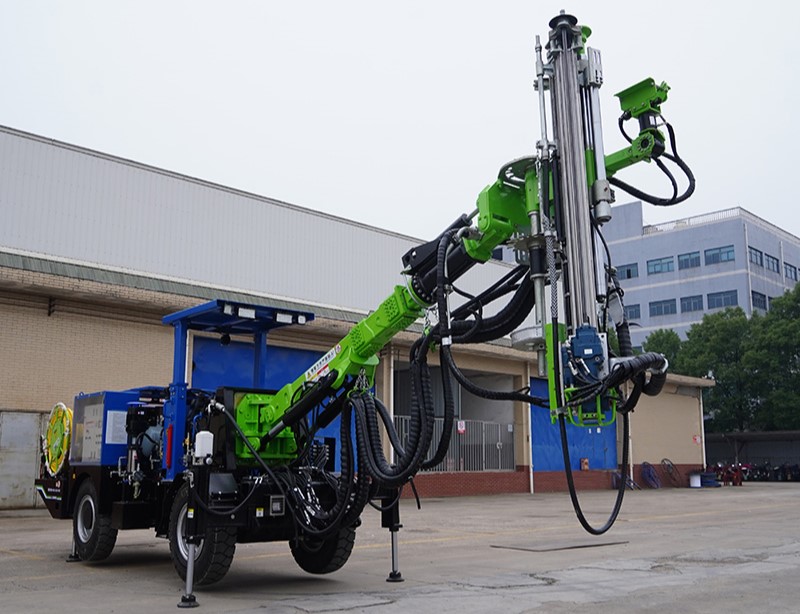Tunnel anchor drilling rigs are specialized equipment used for drilling and installing anchor bolts during tunnel construction. Their core function is to mechanically create anchor holes in the tunnel's surrounding rock (rock wall), providing the foundation for subsequent anchor installation and the establishment of a "surrounding rock-anchor" support system. Ultimately, this improves the structural stability of the tunnel after excavation and prevents surrounding rock collapse or deformation. They are essential equipment in mainstream construction techniques such as the New Austrian Tunneling Method (NATM) and shield-assisted tunneling.

I. Main Classifications of Tunnel Anchor Drilling Rigs
Tunnel anchor drilling rigs can be divided into multiple categories based on their power source, structural form, and construction scenario. Each category has significant differences in adaptability and core advantages.
(I) Classification by Power Type
This is the most core classification method, directly determining the rig's power performance, applicable environment, and operating characteristics.
1. Pneumatic anchor drill: Powered by compressed air, this drill drives a pneumatic motor to rotate the drill rod, which in turn propels the drill string and removes rock cuttings.
2. Hydraulic anchor drill: Powered by hydraulic oil, this drill uses a hydraulic pump to drive the hydraulic motor, while a hydraulic cylinder provides propulsion.
3. Electric anchor drill: Powered by three-phase AC (380V) or DC, the motor directly drives the drill rod.
(II) Classification by Structural Type
Mainly affects the drill's operation, flexibility, and reach.
1. Handheld and portable: Mostly pneumatic (a few are small electric), weighing 3-8kg, requiring manual operation, and equipped with a short drill rod (0.5-1.2m). Their advantage is their flexibility, allowing them to drill shallow holes (≤2m) at any angle (horizontal, vertical, or inclined). Their disadvantage is their high labor intensity, making them suitable only for small areas and temporary support.
2. Outrigger: The mainstream structural type, available in two types: pneumatic and hydraulic outriggers. The drilling rig uses its "outriggers" to press against the tunnel roof or sidewalls, providing reaction force. Operators only need to control the direction and speed, significantly reducing labor intensity. The drilling depth can reach 2-5 meters, and the drilling angle is adjustable (0°-90°), making it suitable for most conventional tunnel support requirements (such as system anchor drilling).
3. Crawler/Trolley-Type: This is the mainstream structure of large hydraulic drilling rigs. It uses a crawler or wheeled trolley as a chassis and is equipped with one to four drill booms, enabling simultaneous drilling at multiple stations. Some high-end models are equipped with laser guidance systems and automatic positioning devices, enabling automated "positioning-drilling-clearing" operations. Their advantages include extremely high efficiency (a single boom can drill 30-50 holes per day) and are suitable for batch support in long and large-section tunnels. However, their disadvantages are their large size, requiring tunnels with a cross-section width of 5 meters or greater to operate.
4. Integrated: Integrates "drilling, anchor bolting, and grouting" functions. Some models come with a built-in anchor bolting mechanism and grouting pump, enabling direct anchor placement and grouting after drilling, reducing equipment changeover time. These rigs are primarily used in soft rock tunnels (IV-V rock mass) where rapid support is required.
II. Applicable Scenarios and Compatibility
1. Support and Reinforcement: System anchoring and locking anchor bolting in highway, railway, and mining tunnels;
2. Disaster Management: Anchoring dangerous landslide rock masses and deep foundation pit support;
3. Auxiliary Operations: Pipe-roof drilling, blasthole construction, and steel arch installation;
Tunnel anchor drill rigs are core equipment for safe tunnel construction. Their dual-arm or triple-arm design, hybrid powertrain, and intelligent control represent cutting-edge technology. Model selection should be based on tunnel cross-section dimensions, rock formation conditions, and construction efficiency requirements (e.g., dual-arm models are suitable for efficient, multi-tasking scenarios).





